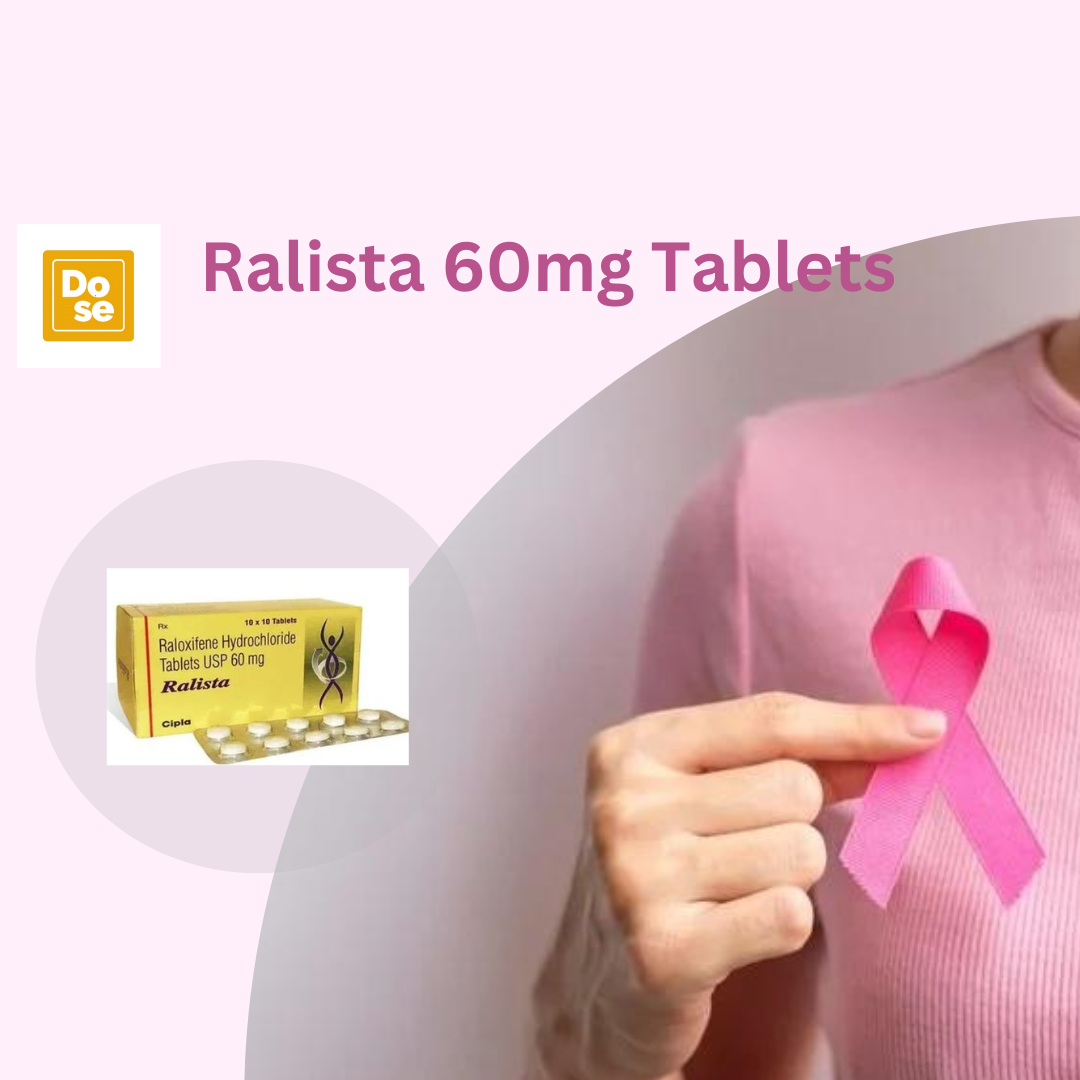Breast Cancer Prevention and Care with Ralista 60mg

Breast cancer remains one of the most common cancers affecting women worldwide. While early detection and timely treatment have significantly improved survival rates, prevention and risk reduction are equally important aspects of managing this disease. Among the various medications that play a role in reducing breast cancer risk, Ralista 60 mg Tablet has emerged as a trusted and effective option for many women.
This article takes a deep dive into how Ralista 60mg works, its role in breast cancer prevention, who can benefit from it, and essential guidelines for its safe and effective use.
Understanding Breast Cancer and the Need for Prevention
Breast cancer occurs when abnormal cells in the breast grow uncontrollably, forming a lump or tumor. While some cases are linked to genetics, lifestyle, and environmental factors also contribute. According to global cancer statistics, millions of new breast cancer cases are diagnosed each year, making prevention a priority for women who are at risk.
Prevention doesn’t just mean avoiding triggers—it also includes proactive medical strategies. For women who have certain risk factors but do not yet have breast cancer, preventive medications like Ralista 60mg can make a significant difference.
What is Ralista 60mg Tablet?
Ralista 60mg Tablet contains Raloxifene Hydrochloride, a selective estrogen receptor modulator (SERM). It is primarily used for two purposes:
- Preventing and treating osteoporosis in postmenopausal women
- Reducing the risk of invasive breast cancer in high-risk women
Ralista works by mimicking estrogen’s beneficial effects on bone density while blocking estrogen’s effects on breast and uterine tissues. This selective action makes it particularly useful for women who need protection from both osteoporosis and breast cancer.
How Ralista 60mg Helps in Breast Cancer Prevention
To understand its preventive action, we need to look at the role of estrogen in breast cancer development.
- Estrogen’s Role: In some women, estrogen stimulates the growth of certain types of breast cancer cells.
- Ralista’s Action: Ralista binds to estrogen receptors in breast tissue but does not activate them, effectively blocking estrogen from triggering abnormal cell growth.
This means that for women with a higher risk of developing hormone-receptor-positive breast cancer, Ralista can help lower the chances of the disease starting in the first place.
Who Can Benefit from Ralista 60mg?
Ralista 60mg is generally prescribed for:
- Postmenopausal women at high risk of breast cancer (due to family history, genetic factors like BRCA mutations, or previous abnormal breast biopsy results)
- Postmenopausal women with osteoporosis who also wish to lower their breast cancer risk
- Women who cannot or do not wish to take hormone replacement therapy due to cancer concerns
However, Ralista is not a general-purpose breast cancer drug and is not recommended for premenopausal women or those who already have invasive breast cancer.
Benefits of Ralista 60mg in Breast Cancer Care
Ralista offers several key advantages for at-risk women:
1. Breast Cancer Risk Reduction
Multiple studies have shown that Ralista can lower the risk of invasive estrogen-receptor-positive breast cancer in postmenopausal women.
2. Bone Health Protection
Ralista also strengthens bones and reduces the risk of fractures, making it a dual-benefit medication for older women.
3. No Increase in Uterine Cancer Risk
Unlike some other SERMs (e.g., Tamoxifen), Ralista does not appear to increase the risk of uterine cancer.
4. Convenient Oral Dosage
A once-daily oral tablet makes it easy to include in a daily health routine.
How to Take Ralista 60mg for Breast Cancer Prevention
Dosage
- Standard Dose: One tablet (60mg) taken orally once daily.
- Can be taken with or without food.
- It’s best to take it at the same time each day for consistency.
Duration of Use
Your doctor will determine how long you should continue Ralista. In many cases, it may be prescribed for several years to provide ongoing protection.
Precautions Before Starting Ralista
Before taking Ralista 60mg, you should inform your doctor if you have:
- A history of blood clots, deep vein thrombosis (DVT), or pulmonary embolism
- Stroke or heart problems
- Liver disease
- Active cancer or a history of invasive breast cancer
- Pregnancy or breastfeeding status (Ralista is not recommended in these cases)
Possible Side Effects
While Ralista is generally well-tolerated, some women may experience mild to moderate side effects:
- Hot flashes
- Leg cramps
- Swelling in hands, feet, or ankles
- Joint pain
- Flu-like symptoms
- In rare cases: Blood clots or stroke
If you notice unusual symptoms such as sudden chest pain, shortness of breath, vision changes, or leg swelling, seek medical attention immediately.
Lifestyle Support for Breast Cancer Prevention
While Ralista 60mg can help reduce risk, it works best when combined with healthy lifestyle practices:
- Maintain a Healthy Diet
Eat plenty of fruits, vegetables, whole grains, and lean protein. Limit red meat, processed foods, and alcohol. - Stay Physically Active
Regular exercise improves hormone balance, strengthens bones, and boosts immunity. - Maintain a Healthy Weight
Obesity increases estrogen levels and breast cancer risk. - Avoid Smoking and Limit Alcohol
Both are linked to higher cancer risk. - Get Regular Screenings
Mammograms and breast exams can detect early changes when they are most treatable.
Ralista vs. Other Breast Cancer Prevention Medications
Ralista is often compared with other SERMs like Tamoxifen. While both can lower breast cancer risk, there are some differences:
| Feature | Ralista | Tamoxifen |
|---|---|---|
| Breast cancer prevention | Yes (postmenopausal women) | Yes (both pre- and postmenopausal women) |
| Osteoporosis benefit | Yes | No |
| Risk of uterine cancer | No significant increase | Slightly increased |
| Blood clot risk | Similar | Similar |
For many postmenopausal women, Ralista offers a safer profile with added bone health benefits.
When Ralista May Not Be the Right Choice
Ralista 60mg may not be suitable if you:
- Are premenopausal
- Are pregnant or breastfeeding
- Have a history of serious blood clotting disorders
- Already have invasive breast cancer
- Need treatment for advanced or metastatic breast cancer
Always consult your healthcare provider before starting Ralista to determine if it’s appropriate for your individual situation.
Tips for Safe Use
- Take your tablet at the same time daily.
- Combine it with adequate calcium and vitamin D intake for bone health.
- Stay physically active to improve circulation and reduce clot risk.
- Report any symptoms of blood clots or stroke immediately.
- Do not stop taking Ralista without your doctor’s advice.
The Bottom Line
Ralista 60mg Tablet offers a valuable preventive option for postmenopausal women who are at high risk of developing hormone-receptor-positive breast cancer. By blocking estrogen’s harmful effects in breast tissue and supporting bone strength, it serves a dual purpose in women’s health.
However, it is not a magic shield. Its effectiveness is maximized when combined with healthy lifestyle choices, regular check-ups, and awareness of personal risk factors. If you think you might benefit from Ralista, talk to your doctor about whether it’s right for you.
Breast cancer prevention is a journey that involves informed decisions, proactive care, and ongoing health monitoring. With Ralista 60mg, many women can take a confident step toward reducing their risk and protecting their well-being.





